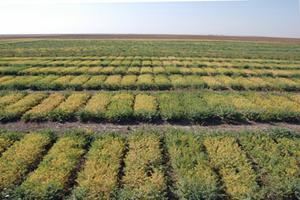Chickpea (Cicer arietinum L.) is part of the legume family. The two primary centres of origin for chickpea are Southwest Asia and the Mediterranean, while Ethiopia is a secondary centre of origin. Today, chickpea represents the third most important pulse crop in the world after dry bean and pea, making up 15% of the world's total pulse production.
Chickpea is a cool-season crop usually grown as a winter crop in India, the Middle East, Australia, and South and Central America. It grows best if daytime temperatures are between 21 and 29ºC and nighttime temperatures are between 18 and 21ºC. The best temperature for germination is 15ºC, however, for desi chickpea, germination can begin when soil temperatures are as low as 5ºC. Chickpea is a relatively drought tolerant crop. Its long taproot allows the chickpea plant to use water to a greater depth than other pulse crops. In the absence of disease, chickpea performs best when there is between 20 and 30 cm of rainfall during the growing season, and when cropped on soils that are well drained.
Chickpea cultivation has several agronomic properties that are beneficial to cropping systems. It increases soil fertility due to the plants' ability to fix atmospheric nitrogen only in association with Cicer specific Rhizobium bacterial species called Bradyrhizobium (the strain which infects lentil and field pea does not work). It also stimulates mycorrhiza populations in the soil to the benefit of other crops in rotation, thus avoiding excessive use of chemical fertilizers and soil acidification.
Chickpea is among the newest crops in Western Canada. The crop is well suited for the semi-arid Brown and Dark Brown Soil zones of this region. The first record of chickpea production in Canada dates back to the 1920s, but sizeable chickpea production can really be traced back to 1997 when 11 000 ha of chickpea were seeded in Saskatchewan. The acreage of chickpea in Western Canada peaked in 2001 when 480 000 ha of chickpea were seeded. Since then the area of production has been fluctuating due to a number of factors such as disease outbreak, adverse weather conditions and relative price compared to other pulses. The average chickpea acreage in Western Canada for the past few years sits around 60 000 ha.
Two different types of chickpeas are produced, each with a separate use and a separate market. The first is the kabuli or garbanzo type, large-seeded, ram-head shape, cream to white-coloured seeds with a thin white seed coat. The seeds are about twice the size of field pea (260 to 600 g/1000 seeds). Kabuli chickpea is often made into snacks (in South Asia), ground into hummus (in the Middle East) or canned whole for the salad bar trade (in North America). The second is the desi type, small-seeded (120 to 300 g/1000 seeds) with a thick, hard and coloured seed coat (from green to purple, brown or black), which is often exported whole to the Indian sub-continent. The desi type is usually prepared for consumption either by dehulling and splitting (chana dal) or by dehulling and grinding into flour (besan). The desi type accounts for about 85 to 90% of the world's chickpea production while the remainder is of the kabuli type. Regarding the origin of the kabuli and desi chickpeas, it is reported that desi originated first followed by kabuli, which was selected from the pool of desi type. Linguistic evidence shows that the kabuli chickpea reached India via the Afghan capital Kabul about two centuries ago and thus acquired the Hindi name "kabuli chana."
Raw chickpea seeds per 100g contain: 357 calories, 4.5-15.69% moisture, 14.9-24.6g protein, 0.8-6.4% fat, 2.1-11.7g fibre, 2-4.8g ash, 140-440mg calcium, 190-382mg phosphorus, 5-23.9mg iron, 0-225mg beta-carotene equivalent, 0.21-1.1mg thiamin, 0.12-0.33mg riboflavin and 1.3-2.9mg niacin. Sprouting is said to increase the proportionate amounts of ascorbic acid, niacin, available iron, choline, tocopherol, pantothenic acid, biotin, pyridoxine, inositol and vitamin K. Chickpea seed contains 17 to 24% protein with essential amino acids such as tryptophan, methionine and cysteine. It is a good source of carbohydrates and proteins, which together constitute 80% of the total dry seed weight. The availability of nutrients from chickpea is calculated to be 12 calories and 0.6g proteins per seed.
Chickpeas are a good source of cholesterol-lowering fibre, as are most other beans. In addition to lowering cholesterol, chickpeas' high fibre content prevents blood sugar levels from rising too rapidly after a meal, making these beans an especially good choice for individuals with diabetes, insulin resistance or hypoglycemia. When combined with whole grains such as rice, chickpeas provide virtually fat-free high quality protein.

 Share on Facebook
Share on Facebook Share on X
Share on X Share by Email
Share by Email Share on Google Classroom
Share on Google Classroom







